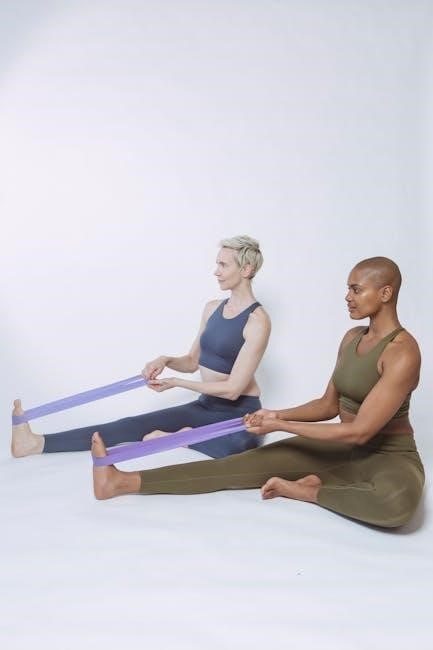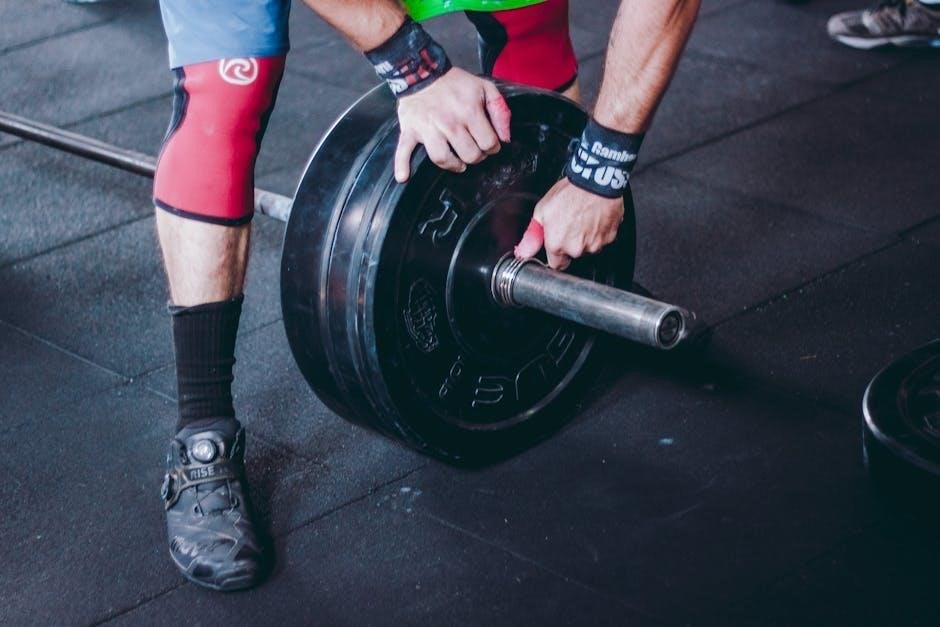This comprehensive 12-week resistance band training program is designed to maximize strength‚ flexibility‚ and muscle growth. Perfect for all fitness levels‚ it offers a structured‚ progressive approach to achieving your goals with minimal equipment. Whether you’re a beginner or an advanced trainer‚ this program provides a flexible and effective way to transform your physique from the comfort of your home or on the go. The program is professionally designed‚ customizable‚ and includes detailed exercises to ensure consistent progress and results.
1.1 Overview of the Program
This 12-week resistance band training program is a structured‚ progressive plan designed to help individuals of all fitness levels achieve their strength and muscle-building goals. It focuses on using resistance bands as the primary training tool‚ offering a portable and cost-effective alternative to traditional weights. The program is divided into four phases‚ each lasting three weeks‚ with exercises tailored to build foundational strength‚ increase intensity‚ focus on hypertrophy‚ and advance training. Each phase incorporates full-body workouts‚ muscle-specific exercises‚ and periodized training methods to ensure continuous progress. The program emphasizes proper form‚ safety‚ and consistency‚ making it ideal for those seeking a flexible yet effective fitness routine.
1.2 Benefits of Using Resistance Bands
Resistance bands are a versatile and accessible training tool offering numerous benefits. They are lightweight‚ portable‚ and cost-effective‚ making them ideal for home workouts or travel. Bands provide continuous tension throughout exercises‚ enhancing muscle engagement and promoting proper form. They are suitable for all fitness levels‚ allowing for easy progression by increasing resistance. Resistance bands are also low-impact‚ reducing joint stress‚ and are excellent for rehabilitation. Their versatility enables a full-body workout‚ targeting major muscle groups effectively. Additionally‚ they are space-efficient‚ requiring minimal storage. These advantages make resistance bands a practical and effective choice for achieving strength‚ flexibility‚ and overall fitness goals in the 12-week program.
1.3 Who Can Benefit from This Program
This 12-week resistance band training program is suitable for individuals of all fitness levels. Beginners can build foundational strength and confidence‚ while intermediate users can enhance their existing routines. Athletes seeking sport-specific training or rehabilitation will find the program beneficial. Busy professionals with limited time or gym access can achieve their fitness goals conveniently. The program is also ideal for those with limited space or equipment‚ as resistance bands are lightweight and portable. Travelers can maintain their fitness regimen on the go‚ and individuals recovering from injuries can use the low-impact nature of resistance bands to aid in recovery. Everyone can benefit from this versatile and effective program.

Understanding Resistance Band Training
Resistance band training offers a versatile‚ portable‚ and cost-effective way to build strength and flexibility. Ideal for all fitness levels‚ it provides continuous tension‚ enhancing muscle engagement and promoting balanced development. The bands are lightweight‚ making them perfect for home or travel workouts‚ and can be customized to suit individual goals‚ whether for rehabilitation‚ sport-specific training‚ or general fitness. This method is highly adaptable‚ allowing users to progress gradually and achieve consistent results without the need for heavy equipment.
2.1 How Resistance Bands Work
Resistance bands create tension when stretched‚ providing continuous resistance throughout exercises. Unlike free weights‚ their resistance isn’t gravity-dependent‚ making them versatile for various movements. The bands’ thickness determines resistance levels‚ and multiple bands can be combined for increased challenge. They engage stabilizer muscles‚ improving balance and functional strength. Portable and lightweight‚ resistance bands are ideal for full-body workouts at home‚ in the gym‚ or while traveling. Their elastic nature allows for controlled movements‚ reducing joint stress compared to traditional weights. This makes them suitable for rehabilitation‚ strength training‚ and enhancing flexibility‚ catering to all fitness levels and goals. Their simplicity and adaptability ensure effective results.
2.2 Types of Resistance Bands
Resistance bands come in various styles‚ each designed for specific purposes. Loop bands are the most common‚ offering versatility for full-body workouts. Tube bands feature handles‚ enhancing grip and control‚ ideal for upper body exercises. Therapy bands are lightweight‚ perfect for rehabilitation and stretching. Mini bands are compact‚ often used for lower body and core exercises. There are also multi-loop bands for progressive overload and cloth-covered bands for comfort. Each type caters to different fitness levels and goals‚ ensuring a tailored approach to strength training. Their variety allows users to choose the best option for their specific needs‚ making resistance bands highly adaptable and effective tools.
2.3 Advantages Over Traditional Weights
Resistance bands offer numerous advantages over traditional weights. They are lightweight‚ portable‚ and require minimal storage space‚ making them ideal for home or travel workouts. Bands are cost-effective and versatile‚ allowing for a wide range of exercises that target multiple muscle groups simultaneously. Unlike heavy weights‚ resistance bands provide continuous tension throughout the movement‚ enhancing muscle engagement. They are also safer‚ as there’s no risk of dropping heavy weights. Additionally‚ bands promote functional movement patterns‚ improving coordination and balance. Their progressive resistance capability ensures a challenging workout at every fitness level‚ making them a practical and efficient alternative to traditional weight training equipment.

Setting Up Your 12-Week Program
This structured program guides you through creating a workout schedule‚ setting fitness goals‚ and selecting the right resistance bands to match your fitness level and objectives.
3.1 Creating a Workout Schedule
A well-structured workout schedule is essential for consistency and progress in your 12-week resistance band training program. Start by designating specific days for upper body‚ lower body‚ and full-body workouts. Aim for 3-4 sessions per week‚ allowing at least one day of rest between sessions. Begin with lighter resistance and gradually increase the intensity as your strength improves. Incorporate a mix of compound movements and isolation exercises to target all major muscle groups. Ensure each session includes a 5-10 minute warm-up and cool-down to prevent injury and enhance recovery. Adjust the schedule as needed to accommodate your lifestyle and progress.
3.2 Setting Your Fitness Goals
Setting clear and achievable fitness goals is crucial for maximizing the effectiveness of your 12-week resistance band training program. Whether your objective is to build muscle‚ improve endurance‚ or enhance overall health‚ defining your goals helps maintain focus and motivation. Start by identifying specific‚ measurable‚ and time-bound targets‚ such as increasing strength or mastering advanced exercises. Use a fitness journal or app to track your progress weekly. Stay flexible and adjust your goals as you advance through the program. Remember‚ consistency and patience are key to achieving long-term success. Celebrate small victories to stay motivated and committed to your fitness journey.
3.3 Choosing the Right Resistance Bands
Selecting the appropriate resistance bands is essential for optimizing your 12-week training program. Consider bands made from durable‚ high-quality materials like latex or fabric for longevity. Choose bands with multiple resistance levels to accommodate progressive overload and varying exercises. Look for bands with comfortable handles or anchor points for versatility. Portability and storage are also key factors‚ as resistance bands are ideal for home or travel workouts. Ensure the bands align with your fitness goals‚ whether focusing on strength‚ hypertrophy‚ or functional training. Affordable and versatile‚ the right resistance bands will enhance your training experience and support consistent progress throughout the program.

Safety and Form
Ensure proper form to prevent injuries and maximize results. Inspect bands for damage before use‚ and start with lighter resistance to build strength gradually. Always warm up and cool down to maintain flexibility and joint health. Focus on controlled movements and avoid snapping or overstretching bands. Consult a professional if unsure about techniques or modifications. Prioritize safety to enjoy a successful and injury-free training experience throughout the program.
4.1 Safety Tips for Resistance Band Training
Always inspect resistance bands for damage before use to avoid unexpected breaks. Ensure proper anchoring and avoid overstretching to prevent snapping. Start with lighter resistance and gradually increase intensity to match your fitness level. Warm up thoroughly to prepare muscles and joints for exercise. Maintain proper form to prevent injuries‚ focusing on controlled movements. Avoid using bands near the face or neck to minimize risk. Keep children and pets away during workouts. Stay hydrated and listen to your body to avoid overexertion. Consult a professional if unsure about techniques or modifications. Prioritize safety to enjoy a successful and injury-free training experience throughout the program.
4.2 Proper Form and Technique
Proper form and technique are essential for maximizing results and preventing injuries during resistance band training. Always engage your core to maintain stability and control. Focus on slow‚ deliberate movements‚ avoiding jerky or bouncy actions that can strain muscles. Keep the band taut throughout exercises to maintain consistent resistance. Ensure full range of motion by stretching the band to its intended length without overextending. Use a neutral grip and avoid twisting wrists or elbows unnecessarily. Pay attention to breathing—inhale during relaxation phases and exhale during effort. Avoid relying on momentum; instead‚ rely on muscle engagement. Proper alignment of the body ensures targeting the correct muscle groups effectively. Consistent form enhances workout efficiency and safety‚ so prioritize technique in every repetition for optimal outcomes.
4.3 Avoiding Common Mistakes
To ensure safety and effectiveness‚ avoid common mistakes during resistance band training. Overstretching the bands beyond their recommended limit can lead to snapping‚ causing injury. Always check bands for wear and tear before use. Another mistake is anchoring the band incorrectly‚ which can reduce tension or cause imbalance. Avoid using bands that are too light or too heavy for your fitness level‚ as this can hinder progress or lead to strain. Additionally‚ neglecting to track your workouts or skipping warm-ups can impede results and increase injury risk. Focus on proper form and technique‚ and consider using online tutorials for guidance. Consistency and attention to detail are key to achieving your fitness goals safely and effectively.

The Structure of the 12-Week Program
The program is divided into four phases‚ each lasting three weeks. It progresses from foundational strength to hypertrophy and advanced training‚ ensuring consistent growth and adaptation.
5.1 Phase 1: Building Foundational Strength (Weeks 1-3)
Phase 1 focuses on establishing a strong foundation through basic resistance band exercises. This initial period introduces essential movements like chest presses‚ rows‚ and squats‚ ensuring proper form and technique. The workouts are designed to gradually increase strength and endurance‚ preparing the body for more intense phases ahead. By mastering these fundamental exercises‚ participants build a solid base that supports long-term progress and minimizes the risk of injury. The emphasis is on consistency and progressive overload‚ with manageable sets and reps that allow for adaptation without overexertion.
5.2 Phase 2: Increasing Intensity (Weeks 4-6)
Phase 2 ramps up the challenge by introducing more demanding exercises and training methods. Participants engage in supersets‚ compound movements‚ and controlled tempos to enhance strength and endurance. Resistance levels are increased‚ and workout volume is expanded to push muscles beyond their current capacity. This phase focuses on refining technique while introducing variations like resistance band-only exercises and dynamic movements. The intensity boost prepares the body for the next stage of growth‚ ensuring continuous progress. Proper form remains a priority to prevent injury‚ while mental resilience is tested as participants are encouraged to push their limits and maintain consistency.
5.3 Phase 3: Focusing on Hypertrophy (Weeks 7-9)
Phase 3 shifts focus to hypertrophy‚ emphasizing muscle growth and size. This phase incorporates higher repetitions‚ extended sets‚ and specialized techniques like isometric holds and slower tempos to maximize time under tension. Resistance levels are adjusted to challenge muscles further‚ while exercise variations target specific muscle groups for balanced development. Progressive overload is emphasized to ensure continuous muscle stimulation. Nutritional advice is tailored to support muscle growth‚ and recovery strategies are highlighted to manage increased intensity. This phase builds on the foundation established earlier‚ pushing participants toward noticeable gains in muscle mass and overall physique transformation by the end of week 9.
5.4 Phase 4: Advanced Training and Progression (Weeks 10-12)
Phase 4 is designed for advanced training‚ focusing on maximizing strength and muscle development. This phase introduces complex exercises‚ multi-planar movements‚ and varied resistance levels to challenge even the most experienced users. Progressive overload is intensified‚ with techniques like band stacking and angle variations to target muscles from multiple directions. The program incorporates dynamic movements and functional exercises to enhance real-world strength and mobility. Nutritional advice is refined to support peak performance‚ and recovery strategies are optimized to handle increased intensity. By week 12‚ participants are prepared for long-term fitness success‚ with a strong foundation for continued growth and advanced training methods.

Exercise Selection and Progression
This section outlines a variety of exercises using resistance bands‚ focusing on upper body‚ lower body‚ core‚ and full-body workouts. It details how to progress exercises by increasing resistance‚ reps‚ or intensity over the 12-week period to ensure continuous muscle growth and strength development.
6.1 Upper Body Exercises
The program includes a variety of upper body exercises using resistance bands‚ such as banded push presses‚ chest presses‚ rows‚ shoulder presses‚ and bicep curls. These exercises target the chest‚ shoulders‚ back‚ and arms‚ promoting muscle growth and strength. The bands provide continuous tension‚ engaging muscles fully throughout each movement. Progression is achieved by increasing resistance levels‚ adding reps‚ or incorporating more complex movements. Proper form is emphasized to prevent injury and maximize results. The exercises are designed to be adaptable‚ catering to both beginners and advanced users. This section ensures a balanced and effective upper body workout‚ essential for overall physique development.
6.2 Lower Body Exercises
The program includes a range of lower body exercises using resistance bands‚ such as banded squats‚ lunges‚ glute bridges‚ and leg curls. These exercises target the quadriceps‚ hamstrings‚ glutes‚ and calves‚ enhancing strength and muscle definition. The bands provide consistent resistance‚ allowing for controlled movements that isolate and engage key muscle groups. Progression is achieved by increasing band tension‚ adding reps‚ or incorporating more dynamic movements. Proper form is emphasized to ensure safety and effectiveness. The exercises are adaptable to different fitness levels‚ making them suitable for both beginners and advanced users. This section helps build a strong‚ balanced lower body foundation.
6.3 Core and Functional Exercises
The program incorporates a variety of core and functional exercises using resistance bands to enhance stability‚ balance‚ and overall athleticism. Exercises like banded planks‚ Russian twists‚ and rotational presses target the abdominals‚ obliques‚ and lower back muscles. Functional movements‚ such as banded step-outs and lateral band walks‚ improve coordination and strength for daily activities and sports. The bands add resistance to bodyweight exercises‚ making them more challenging and effective. These exercises are designed to build a strong‚ functional core that supports overall fitness and injury prevention. Progression is achieved by increasing resistance or adding dynamic movements‚ ensuring continuous improvement throughout the 12-week program.
6.4 Full-Body Workouts
Full-body workouts in the 12-week resistance band training program are designed to target multiple muscle groups simultaneously‚ maximizing efficiency and time. These workouts combine compound exercises like banded chest presses‚ rows‚ and squats‚ which engage the upper body‚ lower body‚ and core in a single session. Resistance bands allow for smooth‚ continuous tension‚ making it ideal for full-body movements that improve coordination and functional strength. The program includes dynamic exercises that simulate real-life movements‚ ensuring practical fitness benefits. By incorporating full-body routines‚ participants can achieve overall muscle balance‚ improve cardiovascular health‚ and enhance metabolic rate‚ all while minimizing workout duration and equipment needs.

Nutrition and Recovery
Nutrition and recovery are crucial for optimal results in the 12-week resistance band training program. A well-balanced diet‚ adequate protein intake‚ and proper hydration support muscle repair and growth. Sufficient rest and sleep are essential for recovery‚ while supplements can enhance performance and muscle recovery. Consistency in nutrition and recovery strategies ensures sustained progress and prevents burnout‚ helping you achieve your fitness goals effectively.
7.1 The Importance of Nutrition in Muscle Growth
A well-balanced diet is essential for muscle growth and recovery during the 12-week resistance band training program. Protein intake is critical for repairing and building muscle fibers‚ while carbohydrates provide energy for workouts. Healthy fats support overall health and hormone production. Hydration is equally important for muscle function and recovery. A calorie-surplus diet ensures muscle growth‚ but portion control prevents excess fat gain. Timing meals and snacks around workouts can enhance performance and recovery. Supplements like protein powder and creatine can further support muscle growth and strength gains. Proper nutrition fuels your body for optimal results‚ making it a cornerstone of this program.
7.2 Recovery Strategies for Optimal Results
Recovery is crucial for muscle growth and overall progress in the 12-week resistance band training program. Adequate sleep‚ hydration‚ and rest days are essential to allow muscles to repair and strengthen. Active recovery techniques‚ such as stretching‚ foam rolling‚ and light cardio‚ can improve circulation and reduce muscle soreness. Overtraining without proper recovery can lead to injuries or plateaus. Incorporating rest days ensures your body rebuilds stronger. Additionally‚ managing stress through meditation or deep breathing can enhance recovery. Prioritizing recovery strategies will help maximize results and keep you consistent throughout the program.
7.3 Supplements for Enhanced Performance
Supplements can enhance your performance and results in the 12-week resistance band training program. Protein powder supports muscle recovery and growth‚ while creatine boosts strength and endurance. BCAAs (branched-chain amino acids) reduce muscle soreness and improve recovery. Multivitamins ensure you’re meeting nutritional needs‚ especially if your diet is lacking. Omega-3 fatty acids reduce inflammation‚ aiding recovery. Pre-workout supplements can increase energy and focus. However‚ always consult a healthcare professional before starting any supplement regimen. Remember‚ supplements should complement‚ not replace‚ a balanced diet. By incorporating the right supplements‚ you can optimize your performance and achieve your fitness goals more effectively.

Tracking Your Progress
Regularly monitoring your workouts‚ strength gains‚ and physical changes ensures accountability and motivation. Tracking progress helps refine your routine‚ celebrate milestones‚ and stay committed to your fitness journey.
8.1 How to Monitor Your Workout Progress
Tracking your workout progress is essential to ensure you’re meeting your fitness goals. Start by logging your exercises‚ sets‚ reps‚ and resistance levels weekly. Take progress photos and measurements to visually track changes. Monitor increases in strength and endurance‚ such as completing more reps or using heavier bands. Adjust your routine based on improvements to stay challenged. Consistency is key‚ so maintain a workout journal to record achievements and identify areas for growth. Celebrate small victories to stay motivated and committed to your 12-week journey. Regular accountability helps refine your program and ensures continuous progress toward your fitness objectives.
8.2 Adjusting the Program Based on Results
Evaluating your progress regularly allows you to tailor the program to your needs. If you’re finding exercises too easy‚ increase resistance by using thicker bands or combining multiple bands. Conversely‚ if workouts feel too challenging‚ reduce resistance or focus on proper form. Adjust the number of sets‚ reps‚ or rest periods based on your performance. Incorporate new exercises or training methods‚ such as HIIT or circuit training‚ to keep the program engaging and effective. Stay consistent with your routine but be flexible enough to make changes that enhance your results. This adaptability ensures continuous improvement and keeps you motivated throughout the 12 weeks.
8.3 Maintaining Motivation Throughout the Program
Maintaining motivation is crucial for completing the 12-week resistance band training program. Start by setting clear‚ achievable goals and celebrating small milestones along the way. Tracking your progress through photos‚ measurements‚ or workout logs can help you see improvements and stay inspired. Incorporate variety by rotating exercises or adding new challenges to keep workouts engaging. Surround yourself with a supportive community or find a workout partner to share the journey. Focus on how resistance band training improves your overall health and well-being‚ not just physical results. Consistency is key‚ so stay committed and remind yourself of the benefits you’re gaining. Motivation grows with progress and accountability.
Congratulations on completing the 12-week resistance band training program! Celebrate your progress and consider transitioning to advanced training for continued growth. Stay consistent and embrace fitness as a lifestyle.
9.1 Celebrating Your Achievements
Celebrating your achievements is a crucial part of your fitness journey. Completing the 12-week resistance band training program is a significant milestone that deserves recognition. Take time to reflect on your progress‚ whether it’s increased strength‚ improved form‚ or a more toned physique. Acknowledge the dedication and effort you’ve put into your workouts. Treat yourself to something special‚ like new fitness gear or a recovery session‚ to mark your success. Sharing your achievements with friends or a fitness community can also be motivating. Remember‚ this is just the beginning—use this momentum to set new goals and continue your fitness journey with confidence.

9.2 Transitioning to Advanced Training
After completing the 12-week resistance band training program‚ you’re ready to transition to advanced training. This phase focuses on increasing intensity‚ introducing more complex exercises‚ and refining your technique. Incorporate higher-resistance bands‚ vary rep ranges‚ and explore full-body workouts to challenge yourself further. Consider integrating advanced techniques like plyometrics or dynamic movements to enhance functional strength. The structured approach of the program can be adapted to more intense routines‚ ensuring continued progress. Use this foundation to explore specialized training methods or set new‚ ambitious fitness goals. The skills and strength you’ve built will serve as the perfect springboard for advanced challenges.
9.3 Staying Consistent with Your Fitness Journey
Consistency is key to maintaining and building on the progress achieved through the 12-week resistance band training program. After completing the program‚ set new fitness goals and incorporate resistance bands into your long-term routine. Track your progress regularly and adjust your workouts to avoid plateaus. Stay motivated by celebrating small victories and sharing your journey with a fitness community. The convenience of resistance bands makes it easy to continue training anywhere‚ anytime. By remaining committed and adaptable‚ you’ll ensure sustained growth and a lifelong dedication to health and wellness. Let the foundation built during these 12 weeks propel you toward ongoing success.

Additional Resources
Download the free 12-Week Resistance Band Training Program PDF for a comprehensive guide. Join fitness communities for support‚ and explore recommended reading and videos for enhanced learning and results.
10.1 Where to Find the 12-Week Program PDF
The 12-Week Resistance Band Training Program PDF is readily available for download on various fitness websites and platforms. You can find it on official fitness portals‚ training websites‚ or community forums dedicated to resistance band exercises. Many sites offer it as a free‚ downloadable resource‚ making it accessible to everyone. Simply search for “12-Week Resistance Band Training Program PDF” on your preferred search engine or visit trusted fitness resources. Some platforms may require registration‚ but the guide is often available without cost. Once downloaded‚ you can print it for easy reference or use it digitally on your devices. This user-friendly guide is designed to help you stay organized and motivated throughout your fitness journey.
10.2 Recommended Reading and Videos
Supplement your 12-week resistance band training program with recommended reading and videos to enhance your understanding and results. Books like “Resistance Band Training” by top fitness experts offer in-depth insights and tips. Online guides and tutorials provide step-by-step instructions for proper form and technique. YouTube channels dedicated to resistance band workouts share creative exercises and routines. Additionally‚ fitness blogs often feature success stories and motivational content to keep you inspired. These resources will help you maximize the benefits of your program and stay consistent with your fitness journey. Utilize these materials to refine your approach and achieve optimal results with resistance bands.
10.3 Joining a Fitness Community for Support
Joining a fitness community can significantly enhance your experience with the 12-week resistance band training program. Online forums‚ social media groups‚ and specialized platforms provide a space to connect with like-minded individuals‚ share progress‚ and gain motivation. These communities often offer tips‚ advice‚ and encouragement to help you stay consistent. Many groups also share additional resources‚ such as workout videos and nutrition guides‚ to complement your training. Participating in a fitness community can help you overcome challenges‚ celebrate milestones‚ and stay accountable throughout your journey. Surrounding yourself with supportive individuals ensures you remain motivated and committed to achieving your fitness goals effectively.




Leave a Reply
You must be logged in to post a comment.